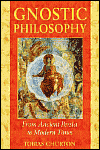
Gnosticism is in. The topic comes up at seminars and pagan gatherings. Everybody’s trying to figure out if neopaganism has gnostic elements or not. Now we have an excellent resource. Churton, who is a British filmmaker and founding editor of a magazine called Freemasonry, has made an extensive study of gnostic philosophers, beginning, in part 1, with Zarathrushtra [sic.], who was really pre-gnostic, to St. Paul, Jesus, and the medieval Fathers of the Church. Part 2 of his book focuses on the Middle Ages, including medieval magic, metaphysics, alchemy, the sufis, the troubadours (a fascinating chapter), the Knights Templar, and the Cathars. Part 3, “Enlightenment,” reveals gnostic elements in the mysticism of Jacob Böhme and William Blake, and tells us possibly more than we want to know about the Rosy Cross and its multitudinous cousins (including freemasonry) from Germany to France to Russia to England.
In a nutshell, gnostic philosophy posits an unknowable creator that is probably light or mind (or both); late in the book, Churton says this unknowable may even be the intelligent protons of the new physics. It’s called the Pleroma and it’s like a fountain. Somehow, somewhen, the unknowable (possibly the Ain Sopf of the Qabalah) flowed (water is another appropriate metaphor) down or out of itself and created the Demiurge. This Demiurge is the crazy god (the God of the Bible) that created the world in all its dualities of “good” and “evil.” Gnosticism seeks to swim upstream, past all dualities and back to the unknowable source. Churton also sees panentheism as a kind of gnosticism.
Pagans like to call Sophia a goddess of wisdom, as if she were another Athena, though sometimes we admit that she’s “the gnostic goddess.” Sophia is not a goddess in the sense we think of goddesses. She is embodied holy wisdom, and her origins lie in the speculations of Alexandrian Jews in the first century of the common era. Churton says that her voice “can be heard crying out” in the familiar paradoxical poetry of The Thunder, Perfect Mind from the Nag Hammadi Library. Sophia is probably closer to Ma’at, Ashera, and Anat Jahu, than any of our more familiar goddesses. To make a long and exceedingly complex story short, Sophia yearns to serve as our lifeguard (to keep using the watery metaphor) and swim with us back to the source that is beyond all the the gods we think we know.
Pagan readers will be especially interested in chapter 10, which concerns Eliphas Levi and the European Occult Revival.” Churton prints a quote from Levi that will sound familiar:
The ancients called practical magic the sacerdotal and royal art, and one remembers that the magi were the masters of primitive [sic.] civilization, because they were the masters of all the science of their time. To know is to be able when one dares to will [emphasis added] (p. 291; the quotation is from Levi’s Key of the Mysteries).
It was Levi who seems to have been the first to connect the Qabalah with the Major Arcana of the Tarot. Levi “believed it was profitable (and many occultists would be happy to agree with him),” Churton writes, to see various correspondences between the Tarot and the Hebrew alphabet, the four letters of the Tetragrammaton, and the ten sephiroth (p. 304). It’s good to learn where some of our “neopagan” ideas really come from.
Pagans will also want to read Part 4, “The Modern Age,” in which Churton discusses gnostic elements in the lives and works of Aleister Crowley, Carl Jung, and Rudolf Steiner, in the new physics, and even in the movies and rock n roll. John Lennon? Jimi Hendrix? Gnostics?? Who knew!
~review by Barbara Ardinger, Ph.D.
Author: Tobias Churton
Inner Traditions, 2005
